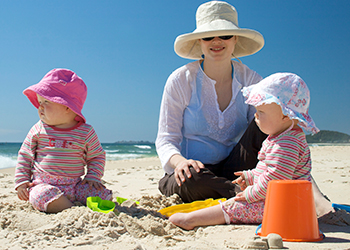Providing and encouraging sun protection for outdoor workers helps create a healthy and safe workplace. It can also increase productivity, which ultimately saves money.
Nearly 5 million people are treated for skin cancer each year in the United States, at an estimated annual cost of $8.1 billion. Skin cancer can be serious, expensive, and sometimes even deadly. Skin cancer cases continue to increase in the United States. Fortunately, most skin cancers can be prevented.

Captain Mike Kirkpatrick of the West Metro Fire Protection District in Lakewood, Colorado, takes sun protection for his firefighters seriously. “Our firefighters put their lives on the line to protect our citizens, and they deserve to be protected from skin cancer,” Kirkpatrick said. “Anyone from Colorado knows the sun here is intense, so we started making small, inexpensive changes to decrease our sun exposure. We provided education to our team about skin cancer prevention and provided sunscreen at all of our fire stations.” These efforts have paid off, according to Kirkpatrick. “Everyone started protecting themselves using a combination of hats, sunglasses, long-sleeved shirts, and sunscreen. It was an easy way to do something valuable for our health.”

Broad spectrum sunscreen with an SPF of 15 or higher is important, but it shouldn’t be your only defense against the sun. For the best protection, use shade, clothing, a hat with a wide brim, and sunglasses, as well as sunscreen.
- The Federal Occupational Safety and Health Act requires employers to minimize risk of harm to employees. In some states, employers may be required to provide workers’ compensation to employees who get skin cancer because of sun exposure on the job.
- Every year, Americans lose more than $100 million in productivity because of restricted activity or absence from work due to skin cancer.
BE AWARE OF RISKS
- Ultraviolet light from the sunOutdoor workers often spend a lot of time in the sun.
- Reflection from bright surfacesReflection from bright surfaces like concrete or metal can increase total sun exposure.
- Sun protectionIt’s easy to overlook sun protection at a busy work site.
USE THESE SUN-SAFE STRATEGIES
UV rays are strongest- From late morning through mid-afternoon.
- Near the equator.
- During summer months.
- At high altitudes.
INCREASE SUN PROTECTION FOR EMPLOYEES
- Encourage sun safety among your employees and provide sun protection when possible. This includes wearing protective clothing; sunglasses; and hats that shade the face, ears, and back of the neck and using broad spectrum sunscreen with an SPF of 15 or higher.
- Schedule breaks in the shade and allow workers to reapply sunscreen throughout their shifts. Modify the work site by— Increasing the amount of shade available—for example, with tents, shelters, and cooling stations. Decreasing UV reflection by covering bright or shiny surfaces.
- Create work schedules that minimize sun exposure. For example, schedule outdoor tasks like mowing for early morning instead of noon, and rotate workers to reduce their UV exposure.
ADD SUN SAFETY TO WORKPLACE POLICIES AND TRAINING
- Include sun-safety information in workplace wellness programs. For example, programs designed to help employees avoid heat illness can be adapted to include information about sun safety.
- Teach outdoor workers about risks of exposure to UV radiation and the signs and symptoms of overexposure.
- Encourage outdoor workers to be role models and discuss the importance of sun protection with patrons, clients, and coworkers. Visit the National Cancer Institute’s RTIPs website to find more information about sun safety programs for outdoor worksites.
SKIN CANCER PREVENTION IN ACTION: FIREFIGHTERS PRACTICE SUN SAFETY

Captain Mike Kirkpatrick of the West Metro Fire Protection District in Lakewood, Colorado, takes sun protection for his firefighters seriously. “Our firefighters put their lives on the line to protect our citizens, and they deserve to be protected from skin cancer,” Kirkpatrick said. “Anyone from Colorado knows the sun here is intense, so we started making small, inexpensive changes to decrease our sun exposure. We provided education to our team about skin cancer prevention and provided sunscreen at all of our fire stations.” These efforts have paid off, according to Kirkpatrick. “Everyone started protecting themselves using a combination of hats, sunglasses, long-sleeved shirts, and sunscreen. It was an easy way to do something valuable for our health.”
CHOOSE SUN-SAFETY STRATEGIES THAT WORK

Broad spectrum sunscreen with an SPF of 15 or higher is important, but it shouldn’t be your only defense against the sun. For the best protection, use shade, clothing, a hat with a wide brim, and sunglasses, as well as sunscreen.


